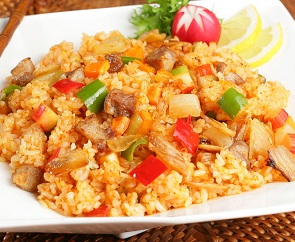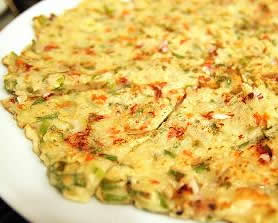Mmm....today I have decided that I will blog about kimchi fried rice or kimchi bokkeumbop (김치볶음밥)You might be thinking "kimchi fried rice? how does that work?" Am I right? Well it was made by housewives who did not want to waste the bits of kimchi left and, you still get the spiciness with delicious fried rice.
Kimchi Bokumbop is a popular restaurant or home prepared dish that is very simple but yet delicious in taste. It can consist of various choices in meat and chopped kimchi, which is then sautéed together along with other vegetables such as onions, garlic and green onions. A dash or more of soy sauce as well as sesame oil are added for seasoning, in addition to kimchi "juice” leftover in the jar. Lastly, an egg is cooked sunny side up and placed on top of this rice dish for taste as well as for decoration.
Usually at home, it's a way to use up kimchi before it gets too ripe to eat, in which case, it can also be used to prepare kimchi chigae. In Korean, bokum means sautéed or fried and bop translates into steamed rice. So essentially, kimchi bokumbop is fried rice with kimchi, and yes, all those stories about Asian restaurants - today's leftover rice is tomorrow's fried rice - is true and totally applies here. There can be infinite variations of this bokumbop dish where beef can be substituted with little bits of galbi, bacon, spam, or even tofu.
Anyways, now that you have got the background, I'll give you guys the recipe too. It really is a simple recipe.
Ingredients
2 cups cooked rice
½ cup kimchi with liquid
½ cup minced pork or ground beef
2 roots green onion
1 tbsp soy sauce
¼ onion
1 clove garlic
1 egg
Vegetable or olive oil
Salt & pepper
COOKING DIRECTIONS
1. Cook rice as directed in a rice cooker or in a pot.
2. Chop kimchi into small pieces. Save kimchi liquid to add to rice, if desired.
3. Dice and mince green onions, onions, and garlic.
4. Season the minced pork or beef with soy sauce, minced garlic and powdered pepper.
5. Sauté the pork (or other substitutes) with vegetable or olive oil in frying pan.
6. When the pork is cooked, add chopped onions, kimchi and cook for 5 minutes.
7. Add minced garlic and green onion. Cook a little more and turn off the heat.
8. Add cooked rice and mix all ingredients well.
9. Add 1-2 tbsp of sesame oil and re-heat again.
10. Add salt and pepper to meet taste.
11. Cook egg sunny side up
12. Put rice on a dish and place a fried egg sunny side up on top.

And there you have it, a delicious lunch or dinner that is simple to make and sure to tickle your taste buds.
Anyways, that is all from me today. I'll try and come back with another recipe in a couple of days. ^^
 Another variety is dongnae pajeon (동내파전) is named after Dongnaesung , a former fortress in the Joseon Dynasty and now a district in the city of Busan. Dongnae was a prominent battleground during the Imjin War and legend says the people of Dongrae threw green onions while defeating the invading Japanese soldiers. Dongnae pajeon was made in honor of the victory.
Another variety is dongnae pajeon (동내파전) is named after Dongnaesung , a former fortress in the Joseon Dynasty and now a district in the city of Busan. Dongnae was a prominent battleground during the Imjin War and legend says the people of Dongrae threw green onions while defeating the invading Japanese soldiers. Dongnae pajeon was made in honor of the victory.





